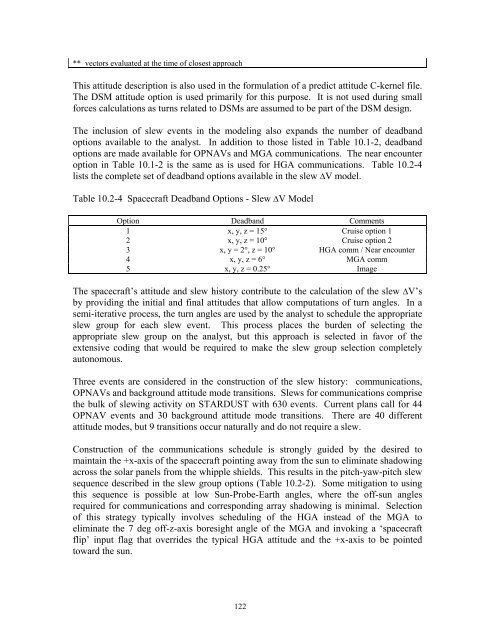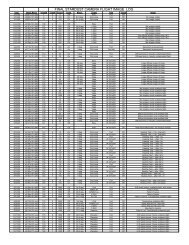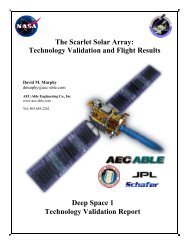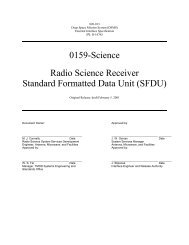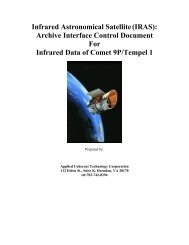MISSION PLAN - PDS Small Bodies Node
MISSION PLAN - PDS Small Bodies Node
MISSION PLAN - PDS Small Bodies Node
You also want an ePaper? Increase the reach of your titles
YUMPU automatically turns print PDFs into web optimized ePapers that Google loves.
** vectors evaluated at the time of closest approach<br />
This attitude description is also used in the formulation of a predict attitude C-kernel file.<br />
The DSM attitude option is used primarily for this purpose. It is not used during small<br />
forces calculations as turns related to DSMs are assumed to be part of the DSM design.<br />
The inclusion of slew events in the modeling also expands the number of deadband<br />
options available to the analyst. In addition to those listed in Table 10.1-2, deadband<br />
options are made available for OPNAVs and MGA communications. The near encounter<br />
option in Table 10.1-2 is the same as is used for HGA communications. Table 10.2-4<br />
lists the complete set of deadband options available in the slew ∆V model.<br />
Table 10.2-4 Spacecraft Deadband Options - Slew ∆V Model<br />
Option Deadband Comments<br />
1 x, y, z = 15° Cruise option 1<br />
2 x, y, z = 10° Cruise option 2<br />
3 x, y = 2°, z = 10° HGA comm / Near encounter<br />
4 x, y, z = 6° MGA comm<br />
5 x, y, z = 0.25° Image<br />
The spacecraft’s attitude and slew history contribute to the calculation of the slew ∆V’s<br />
by providing the initial and final attitudes that allow computations of turn angles. In a<br />
semi-iterative process, the turn angles are used by the analyst to schedule the appropriate<br />
slew group for each slew event. This process places the burden of selecting the<br />
appropriate slew group on the analyst, but this approach is selected in favor of the<br />
extensive coding that would be required to make the slew group selection completely<br />
autonomous.<br />
Three events are considered in the construction of the slew history: communications,<br />
OPNAVs and background attitude mode transitions. Slews for communications comprise<br />
the bulk of slewing activity on STARDUST with 630 events. Current plans call for 44<br />
OPNAV events and 30 background attitude mode transitions. There are 40 different<br />
attitude modes, but 9 transitions occur naturally and do not require a slew.<br />
Construction of the communications schedule is strongly guided by the desired to<br />
maintain the +x-axis of the spacecraft pointing away from the sun to eliminate shadowing<br />
across the solar panels from the whipple shields. This results in the pitch-yaw-pitch slew<br />
sequence described in the slew group options (Table 10.2-2). Some mitigation to using<br />
this sequence is possible at low Sun-Probe-Earth angles, where the off-sun angles<br />
required for communications and corresponding array shadowing is minimal. Selection<br />
of this strategy typically involves scheduling of the HGA instead of the MGA to<br />
eliminate the 7 deg off-z-axis boresight angle of the MGA and invoking a ‘spacecraft<br />
flip’ input flag that overrides the typical HGA attitude and the +x-axis to be pointed<br />
toward the sun.<br />
122


